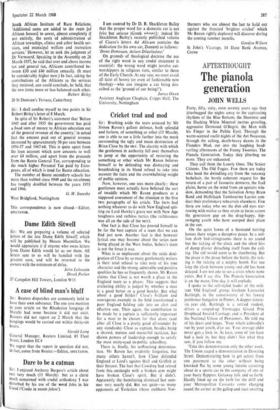International Boer
Sir: Professor Manning (Letters, 15 March) says that I have conceded that General Smuts had before him the product of Dumbarton Oaks when he formulated the draft preamble for the United Nations' Charter. I conceded nothing. Having read the book I was reviewing (quite apart from any knowledge I had acquired of the subject before), I was quite aware of this. I did not refer to it because it seemed to me irrelevant. Certainly the Dumbarton Oaks draft referred to what we now call 'fundamental human rights,' but so did the Atlantic Charter before it and the French Declaration of the Rights of Man and the American Declaration of Independence and, for that matter, the New Testament. But the significance of Smuts's 'noteworthy intervention' (to use Sir Keith Han- cock's words) is dealt with in his book, and perhaps I may leave it at that. Professor Manning's defence of the system of financing African education in South Africa seems to me more important. He counters my figures for school education with those for university education. I wonder if he has exag- gerated a little. According to the Report of the Controller and Auditor-General for 1964-65 the cost to the state for each student in 1964 was £241 les at the white universties and at the three African university colleges £1,072 10s, £610 les and £833 lOs respectively. This is not 'more than six times as much,' but it is impressive. It is largely due to the very remarkable staffing ratios. In 1966 there were at these three col- leges 1:4, 1:6 and 1:5. It might be suggested, however, that in Order to create an 6lite it would be as well to pay more attention to secondary education. The African population of South Africa is 12,750,000, more than a quarter that of England. The total number of African chil- dren who took the matriculation examination in 1966 was 1,547, and the number who passed with university entrance was 411. It is going to take some time to produce an 6lite with such low figures. Secondary education for Africans will never be in the position to do this until more money is spent on it. It cannot be right to keep the amount contributed from the general revenue of the country unchanged when the number of children at school doubles. Perhaps we might put schools and universities together. The South African Institute of Race Relations has calculated that in 1965-66 the expenditure per head of population on education was for the whites £37 3s and for the Africans £1 4s.
Professor Manning refers to the general tax of 35s per annum on the Africans. This is the figure for a male whose taxable income is less than £100 a year. If his income is, say, £400 a year, it is £4 5s (or £4 for a female). Professor Manning simply ignores indirect taxation. It must not be thought that the African gets his hospitals for nothing. To quote again from the
South African Institute of Race Relations, 'Additional sums are added to the rents [of African houses] to cover, almost completely if not entirely, the costs of administration of African townships, clinics and other health ser- vices, and municipal welfare and recreation services.' However, let us seek the judgment of Dr Verwoerd. Speaking in the Assembly on 28 March 1957, he said that over and above income tax and general tax, Africans contributed be- tween £30 and £40 million annually. (It must be considerably higher now.) In fact, taking the contributions of the Africans to the services they received, one could conclude, he held, that the two items more or less balanced each other.







































 Previous page
Previous page